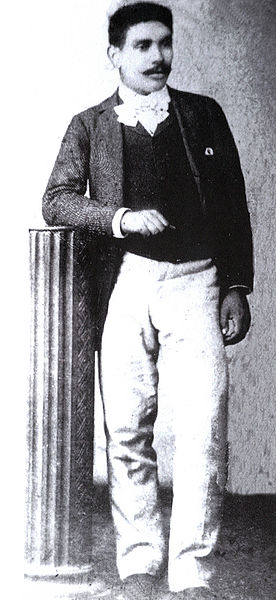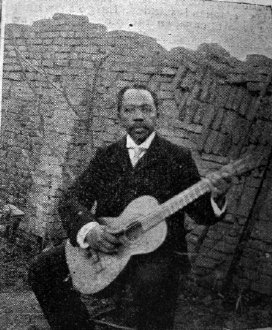<Back to Index>
- Composer and Pianist Anselmo Rosendo Mendizabal Cayetano, 1868
- Composer and Guitarist Gabino Ezeiza, 1858
PAGE SPONSOR

Rosendo Mendizabal, whose full name was Anselmo Rosendo Mendizabal Cayetano and sometimes signed A. Rosendo, was a prominent composer and pianist of the early days of tango, born in Buenos Aires, Argentina, on April 21, 1868, and died in the same city on June 30th, 1913 . He was the author of the first tango led to a score.
Of Afro - Argentine ancestry, he was of a well - off family. His father, Horace, had published poetry books: First poetry and meditation hours. Anselmo, who in 1875 received a sizable inheritance by the death of his grandmother, studied music and had the title of professor of piano at a conservatory, which placed him at an advantage over other players.
As a pianist he was famous for the unique use of his left hand. He played once a month for a group of about 40 friends who belonged to the Z Club. That day entry was not permitted to those not part of the group except for the commissioner Enrique Otamendi, who used to pass by. Since at that time there was no copyright, it was customary for the musician who premiered a work, whose name would appear later in the score, to receive a $100 bill. Hence there are many tangos of the time with names of such persons. Say, the recipient of the Entre Rios was a club member Ricardo Segovia, born in Entre Rios. Rosendo was another tango later called the Entre Rios, which, however did not reach the popularity of the preceding one.
Mendizabal
squandered his inheritance and played the piano
in places of very different types, ranging from clandestine brothels to
dance schools and houses, some with modest clientele and others as "The
old Eustaquia", "The brown Adelina ", "Laura's" and "Mary the Basque", where people would be of higher social class. Some consider him the best pianist of the Old Guard and its most famous tango, The entrerriano, may be the first to be a score between 1897 and 1898.
After
two years of being ill, almost blind, bedridden with paralysis and
almost destitute, he died in Buenos Aires on June 30, 1913.

Gabino Ezeiza, was an Afro - Argentine nicknamed the Black Ezeiza (Buenos Aires, in the neighborhood of San Telmo, February 3 of 1858 - ditto, in the neighborhood of Flores, October 12 of 1916 ) Argentine musician and minstrel.
Ezeiza was famous in the art of Payar, both in his land and in Uruguay. His counterpoint became famous and is particularly remembered for a July 23, 1884 concert at the Teatro Artigas in Montevideo with the singer Juan de Nava. That event was very well attended and Ezeiza improvised what would be the famous song Heroic Paysand˙, becoming one of the two most famous payadores in history (along with Santos Vega). July 23 was declared "Payador Day" throughout the territory of Argentina in honor of this historic counterpoint.
Another of his memorable payadas was staged at Buenos Aires with the famous Paul J. Vazquez, in 1894.
Gardel and Razzano knew
him through political committees, like almost all the minstrels of the time,
and he was treated as a friend. At his death, the duo sang in his honor Heroic Paysand˙, which years later was recorded by Gardel.
Gabino Ezeiza is considered the best all time minstrel, who introduced the milonga rhythm in the minstrel song. Gabino said the milonga comes from the Candomble, which was formed from old African rhythms. Gabino Ezeiza was born in San Telmo (a former slave quarters), and lived in a time when there was a considerable number of black African descendants in the area of the current Greater Buenos Aires, and also, his teacher at the beginnings of the minstrel song, Pancho Luna, was of African descent.
Gabino Ezeiza was inspired by the African roots of the Afro-Argentine milonga rhythm, and introduced the payada. That is, the milonga rhythm would have been an evolution using Creole guitar of the Afro-Argentine candombe performed by the Afro-Argentine Pampa in Argentina. Then Gabino introduced it into the minstrel song. From then on, due to the great reputation of Gabino Ezeiza, in the minstrels were introduced the payando and increasingly the milonga in figure and in style. Over time, this rate would extend both to other areas of Argentina and in Uruguay and Brazil (especially in the south).